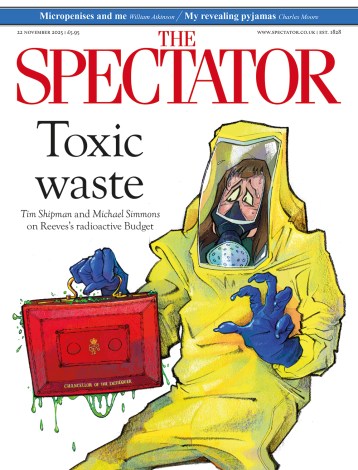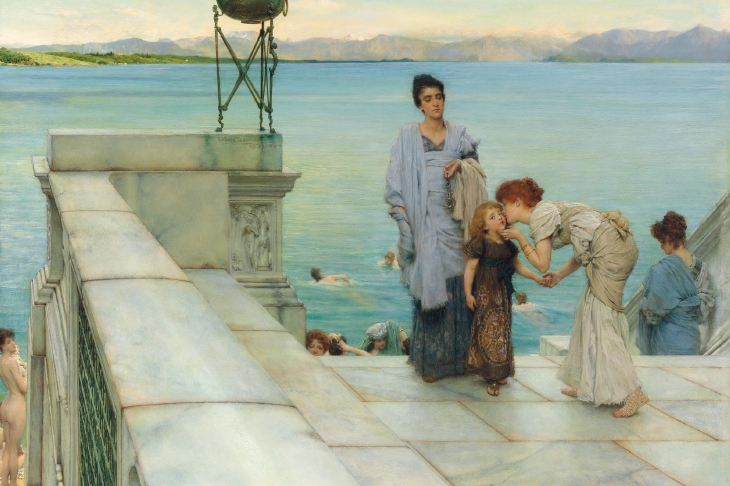On 15 September 1888 Vincent van Gogh was intrigued to read an account of an up-to-date artist’s house in the literary supplement of Le Figaro. This described a purple house in the middle of a garden, the paths of which were made of yellow sand. The walls were glass bricks ‘in the shape of purple eggs’.
Such aesthetic dwellings were all the rage; Van Gogh dreamed of having one himself in Arles. But as one learns from an exhibition at Leighton House, it was another 19th-century Dutch artist, Lawrence Alma-Tadema, who actually inhabited two such establishments — one off Regent’s Park, the other in St John’s Wood.
On paper, Van Gogh and Alma-Tadema have a great deal in common. The former was born in 1853 in a small village in the south of the Netherlands, the latter, 17 years older and originally christened Lourens, came from Dronryp, a tiny settlement in the extreme north. Van Gogh’s father was a clergyman, Alma-Tadema’s a lawyer. Both were determined to become painters in the face of family opposition.
‘If I have obtained any degree of success,’ Alma-Tadema proclaimed, ‘it is because I have always been faithful to my own ideas.’ Van Gogh was faithful to his, too, but of course he did not enjoy much success before his death in 1890. And that, in fact, is where the comparison ends.
Alma-Tadema’s career was, in worldly terms, as triumphant as an artist’s could possibly be. He died, in 1912, knighted and a member of the Order of Merit, and was buried in the crypt of St Paul’s Cathedral. The other difference was that Van Gogh was a great painter and, as this exhibition demonstrates clearly, Alma-Tadema was not.
Admittedly, he had other talents: as a maker of stylish interiors and as a showman, both of which are investigated in this mini-retrospective, Alma-Tadema: At Home in Antiquity. One of the most interesting parts of the exhibition (I am surprised to report, since I usually hurry past these things) is the video room. This documents how Alma-Tadema’s paintings of ancient Greek and Roman life were echoed in films, from Cecil B. DeMille’s era to Ridley Scott’s. These aren’t vague resemblances: shot after shot quite precisely follows these Victorian and Edwardian pictures, almost as if Alma-Tadema had posthumously directed them.
It’s no surprise to discover that he was a successful stage designer in the 1890s. The trouble is that the actual pictures are both stagey and cinematic — like hand-painted stills. The archaeological detail is marvellously accurate, but the whole effect is tremendously unconvincing, and sometimes downright absurd.
‘The Roses of Heliogabalus’ (1888) is perhaps the most memorably silly of Alma-Tadema’s many classical extravaganzas. This decadent emperor Heliogabalus allegedly decided to suffocate his guests underneath a shower of scented petals. In the painting, his victims, looking like Victorian ladies in Roman costume, react with expressions of mild concern.
The evocation of the interiors at Alma-Tadema’s second London home, at 17 Grove End Road, St John’s Wood, are the most enjoyable part of this exhibition. This was more an artist’s mansion than a humble house. Effectively, Alma-Tadema took up residence inside one of his paintings; indeed, this huge Italianate villa, like its predecessor, was the setting for several pictures. The sumptuous Leighton House — a much better work of art than any pictures by its owner, the painter Frederic Leighton — is the perfect place to consider thesuccess and failure of Alma-Tadema.
One of Leighton’s most prominent works is ‘Cimabue’s Celebrated “Madonna”’ (1853–5), which hangs in the entrance to the National Gallery. Rather like an Alma-Tadema, it looks like a 19th-century theatrical recreation: in this case, not of classical antiquity but medieval Florence. Nearby, in Room One, there is a delightful little exhibition devoted to one of Cimabue’s lesser known contemporaries: Giovanni da Rimini.
This Giovanni is not much more than a name, as is true of even the most celebrated of 14th-century Italian artists. But this scholarly little show makes his artistic personality clearer. Like the other painters of Rimini, he had been affected by the presence in town of Giotto. The National Gallery’s own ‘Pentecost’ by the great man and his workshop — possibly painted in Rimini — is part of the display.
However, Rimini is also an Adriatic town not far from Venice and in contact with the world of Constantinople. Two of the most beautiful exhibits are Byzantine ivory panels, tiny, delicately carved, and evidently the kind of thing some Italian artists looked at closely.
Giovanni da Rimini’s precious, gold-backed paintings — more like miniatures than altarpieces — strongly resemble these ivories in composition and scale. But there’s something else: a soft prettiness about the faces of his Madonnas and saints that is neither Florentine nor Byzantine, but perhaps a bit Venetian.






Comments